by Amineddoleh & Associates LLC | Jul 23, 2018 |
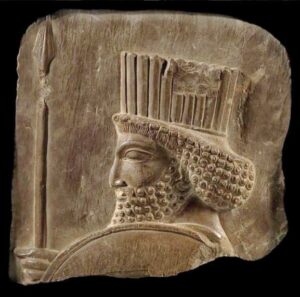 Amineddoleh & Associates is excited to share some great news. A looted Persian artifact is returning to Iran. Back in the autumn, our founder, Leila A. Amineddoleh, brought the object to the attention of the Manhattan DA’s Office after receiving a tip from Dr. Lindsay Allen. The DA began investigating the piece and then seized it from TEFAF. After months of battling over this rare and magnificent work, the piece is being repatriated to Iran. In addition to being the “informant,” Ms. Amineddoleh also served as the heritage law expert in this matter, so this case is particularly exciting for our law firm. Congratulations on the excellent work done by the entire Antiquities Trafficking Unit at the Manhattan DA’s Office.
Amineddoleh & Associates is excited to share some great news. A looted Persian artifact is returning to Iran. Back in the autumn, our founder, Leila A. Amineddoleh, brought the object to the attention of the Manhattan DA’s Office after receiving a tip from Dr. Lindsay Allen. The DA began investigating the piece and then seized it from TEFAF. After months of battling over this rare and magnificent work, the piece is being repatriated to Iran. In addition to being the “informant,” Ms. Amineddoleh also served as the heritage law expert in this matter, so this case is particularly exciting for our law firm. Congratulations on the excellent work done by the entire Antiquities Trafficking Unit at the Manhattan DA’s Office.
For more information about the case, read our earlier post: https://www.artandiplawfirm.com/right-for-plundered-persian-relief/
To read today’s filing, click here: 18-07-23 PGR Turnover Order
by Amineddoleh & Associates LLC | Jun 3, 2018 |
Note: All of the information in this blog post is taken from a publicly filed document. No confidential or privileged information was used in preparing this post.
 Last month, Assistant District Attorney Matthew Bogdanos petitioned the NY Supreme Court to turn over an Achaemenid limestone bas-relief that had been looted from Iran. Referred to as a “Persian Guard Relief,” the rare object was stolen from Persepolis in 1935. Our founder, Leila A. Amineddoleh, was instrumental in the filing of this case.
Last month, Assistant District Attorney Matthew Bogdanos petitioned the NY Supreme Court to turn over an Achaemenid limestone bas-relief that had been looted from Iran. Referred to as a “Persian Guard Relief,” the rare object was stolen from Persepolis in 1935. Our founder, Leila A. Amineddoleh, was instrumental in the filing of this case.
Persepolis, in current day Iran, is one of the world’s most treasured historical sites, with its name derived from Greek, meaning “Persian city.” Persepolis is considered by UNESCO to have “outstanding universal value.” UNESCO describes Persepolis as “magnificent ruins…among the world’s greatest archaeological sites… among the archaeological sites which have no equivalent and which bear unique witness to a most ancient civilization.” In 1931 excavations were begun at the site, and UNESCO declared the ruins a World Heritage Site in 1979.
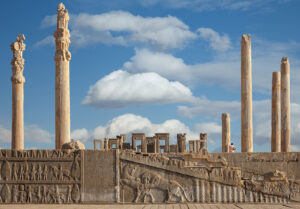
Persepolis
© BornaMir/iStock.com
The ancient city, dating back to at least 515 B.C., was the capital of the Achaemenid Empire. Persepolis was built in terraces up from the river Pulwar to rise on a larger terrace of over 125,000 square feet, partly cut from a mountain. Darius I began construction of the site, and it developed until the Greeks plundered and razed the city under the leadership of Alexander the Great in 333 BC (purportedly in retribution for the destruction of the Parthenon by the Persians in 480 BC). The city was widely known as spectacular and breath-taking. As part of the site, Darius I built a palace known as the “Apadana,” used for official audiences. The looted relief at issue was stolen from this great hall.
The looted limestone bas-relief was stolen from Persepolis in 1935, during official excavations completed by the Oriental Institute at the University of Chicago. Authorities were alerted to the theft, and the Iranian government attempted to find and recover the piece, but it disappeared and entered the global black market, eventually making its way into a Canadian museum. Decades later, it was stolen from the museum, recovered, and then appeared at TEFAF in New York in the fall of 2017. At that point, the work was seized by the NY District Attorney’s Office after they learned of the work’s illicit origins. Our founder, Leila Amineddoleh, had informed authorities about the piece after learning about its plundered past by Dr. Lindsey Allen, Lecturer in Greek & Near Eastern History at King’s College in London. As the result of several years examining fragmentary reliefs from the site in museums around the world, and searching archives for their histories, Dr. Allen suspected the relief was looted. When Wace exported the relief for TEFAF, Dr. Allen contacted Ms. Amineddoleh, and explained why she thought the work was stolen.
Iran safeguards Persepolis due to its historic significance. In fact, Iran protects all of its cultural heritage, with the nation’s first patrimony laws passing in 1930. Because of these laws, there is no way that the relief left Iran legally, absent permission from the cultural ministry. Ms. Amineddoleh served as an expert to the District Attorney’s Office in advising on the relevant cultural heritage laws.
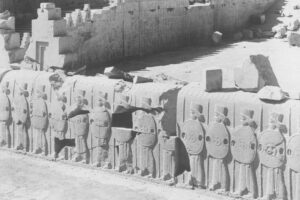
The eastern stairs at the Apadana in 1933.
(Photo: The Oriental Institute of University of Chicago, Photo 23188/ Neg.Nr. 12822
https://oi-idb.uchicago.edu/id/bec348b2-7e3c-49fd-8fd6-e9f057c92c4e)
The District Attorney’s Office submitted its turnover request on May 24 (read the document HERE: 18-05-24 PGR Motion for Turnover-reduced), but the case may carry on for some time. The limestone relief, part of an historical complex, has significance not only to the people of Iran, but to archaeologists and classicists, and to anyone visiting Iran’s most celebrated archaeological site. The limestone relief’s theft from Persepolis was tragic and damaging to the site, and hopefully the limestone guard will return to his home protecting the ancient site. The guards are designed to work in the site as a collective, not as individuals. Their fragmentation removes their context, and high-profile sales make other Achaemenid ruins potentially vulnerable to plunder.
by Amineddoleh & Associates LLC | May 3, 2018 |
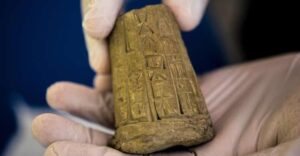
Photo courtesy of U.S. Immigration and Customs Enforcement (ICE)
Our founder, Leila A. Amineddoleh, served as a cultural heritage law expert for the Eastern District of New York in its case against Hobby Lobby. The national retail chain, Hobby Lobby, purchased over 5,500 ancient artifacts from dealers in the Middle East, after one of the world’s legal heritage experts, Patty Gerstenblith, warned the company about acquiring objects lacking clear provenance. She warned the company that classes of objects from Iraq (including cuneiform tables) have a high probability of being looted from archaeological sites. Ignoring the advice, the company moved forward with the purchases anyway, and the plundered artifacts (bearing shipping labels with falsified information) entered the US illegally.
Yesterday, nearly 4,000 of the pieces were returned to Iraqi officials at the embassy. These objects will most likely be displayed at Iraq’s National Museum.
Our firm is honored to have played a role in such a momentous repatriation. For more information about the case, please read one of our prior blog posts.
by Amineddoleh & Associates LLC | Jan 5, 2018 |

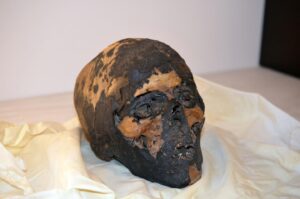 The new year is off to a great start with another international repatriation. Later this month, fragments of a mummy will be returned to the Arab Republic of Egypt. The skull and two dismembered hands were taken from Egypt in the 1920s in violation of the nation’s antiquities laws. Leila Amineddoleh served as the cultural heritage law expert for the government.
The new year is off to a great start with another international repatriation. Later this month, fragments of a mummy will be returned to the Arab Republic of Egypt. The skull and two dismembered hands were taken from Egypt in the 1920s in violation of the nation’s antiquities laws. Leila Amineddoleh served as the cultural heritage law expert for the government.
Read about the case HERE.
by Amineddoleh & Associates LLC | Jul 23, 2015 |
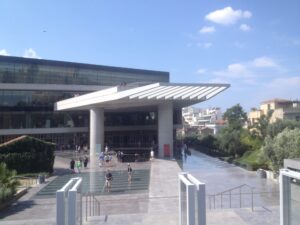 I have expressed my support of the British Museum’s return of the Parthenon Marbles to Greece. Contrary to the many assumptions made in the emails I received after publication of a my op-ed in Forbes, a Letter to the Editor in the NY Times, and my prior blog posts on this topic, my ethnicity is not Greek. Rather, I advocate for the restitution of the Parthenon Marbles because it is the right thing to do. Further, as an attorney I believe there is a basis for Greece to demand restitution of the works. Although litigation is not the best option for Greece, the Mediterranean nation has many tools at its disposal, such as negotiations, cooperative projects with the British Museum, and long-term loans.
I have expressed my support of the British Museum’s return of the Parthenon Marbles to Greece. Contrary to the many assumptions made in the emails I received after publication of a my op-ed in Forbes, a Letter to the Editor in the NY Times, and my prior blog posts on this topic, my ethnicity is not Greek. Rather, I advocate for the restitution of the Parthenon Marbles because it is the right thing to do. Further, as an attorney I believe there is a basis for Greece to demand restitution of the works. Although litigation is not the best option for Greece, the Mediterranean nation has many tools at its disposal, such as negotiations, cooperative projects with the British Museum, and long-term loans.
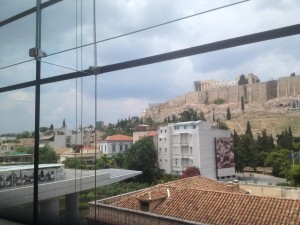 I have memories of my first trip to Greece, taken back in 2006, during which time I visited dozens of museums and heritage sites. I was in awe of the cultural wealth of the ancient nation. As the years passed, memories faded, but I never lost sight of the richness of the country’s cultural heritage. Luckily I had the opportunity to return to the cultural giant this summer. I was thrilled with the state-of-the-art facilities at the new Acropolis Museum. The museum is at the foot of the Acropolis, the most recognized structure of the ancient world; the historic mount is visible from the windows of the museum, with the most breath-taking views from the outdoor café. Not only is the Acropolis visible in the distance, but the Parthenon can be seen in distinct detail. The Acropolis Museum’s brightly lit galleries display what remains of the Acropolis Marbles in Greece. Seeing the remains of the objects in the museum next to their birthplace gave me greater appreciation for them, but it also angered me. The museum curators did a wonderful job in labeling the works and identifying objects currently in possession of the British Museum and being withheld from their Greek homeland. Plaster copies are on display, allowing visitors to view copies of the original objects that are being held hostage at the British Museum; the displaced objects are displayed with a British Museum “BM” notation underneath. Each “BM” is a bitter reminder that the marbles are not in their rightful location.
I have memories of my first trip to Greece, taken back in 2006, during which time I visited dozens of museums and heritage sites. I was in awe of the cultural wealth of the ancient nation. As the years passed, memories faded, but I never lost sight of the richness of the country’s cultural heritage. Luckily I had the opportunity to return to the cultural giant this summer. I was thrilled with the state-of-the-art facilities at the new Acropolis Museum. The museum is at the foot of the Acropolis, the most recognized structure of the ancient world; the historic mount is visible from the windows of the museum, with the most breath-taking views from the outdoor café. Not only is the Acropolis visible in the distance, but the Parthenon can be seen in distinct detail. The Acropolis Museum’s brightly lit galleries display what remains of the Acropolis Marbles in Greece. Seeing the remains of the objects in the museum next to their birthplace gave me greater appreciation for them, but it also angered me. The museum curators did a wonderful job in labeling the works and identifying objects currently in possession of the British Museum and being withheld from their Greek homeland. Plaster copies are on display, allowing visitors to view copies of the original objects that are being held hostage at the British Museum; the displaced objects are displayed with a British Museum “BM” notation underneath. Each “BM” is a bitter reminder that the marbles are not in their rightful location.
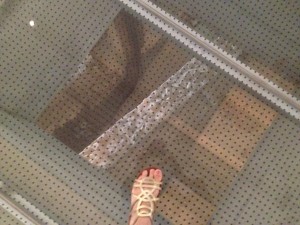 In addition to the marbles from the Acropolis, the museum highlights many impressive aspects of Greece’s ancient history. The entrance to the sleek museum features glass floors that allow visitors to view the archaeological remains beneath the museum; context doesn’t get any better than that. Contrary to the arguments made by the British Museum, the Acropolis Museum is a bustling site, a reflection of the ancient Acropolis itself. There was a long line of people waiting for tickets when I visited on a Tuesday morning in June. The museum was packed with visitors, from the café to the gift shop to the bright and sunny rooms throughout the modern building. The sight of so many tourists spurred me once again to question the validity of tourism statistics cited by the British Museum as a reason for withholding the Parthenon Marbles. And even if the British Museum has a greater number of visitors, are they all there for the Parthenon Marbles? Clearly all visitors to Athens’ Acropolis Museum are there with the intention to see the impressive carvings from the Acropolis, including the Parthenon Marbles.
In addition to the marbles from the Acropolis, the museum highlights many impressive aspects of Greece’s ancient history. The entrance to the sleek museum features glass floors that allow visitors to view the archaeological remains beneath the museum; context doesn’t get any better than that. Contrary to the arguments made by the British Museum, the Acropolis Museum is a bustling site, a reflection of the ancient Acropolis itself. There was a long line of people waiting for tickets when I visited on a Tuesday morning in June. The museum was packed with visitors, from the café to the gift shop to the bright and sunny rooms throughout the modern building. The sight of so many tourists spurred me once again to question the validity of tourism statistics cited by the British Museum as a reason for withholding the Parthenon Marbles. And even if the British Museum has a greater number of visitors, are they all there for the Parthenon Marbles? Clearly all visitors to Athens’ Acropolis Museum are there with the intention to see the impressive carvings from the Acropolis, including the Parthenon Marbles.
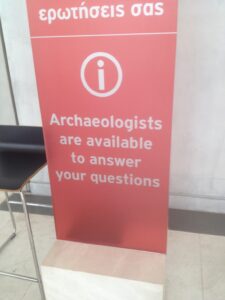 Furthermore, the museum houses a vast array of objects from Athens, as well as others parts of Greece, in an attempt to present the Acropolis marbles in their original and appropriate context. The objects are clearly labeled and explained in both Greek and English so that even the novice history enthusiast can understand and enjoy the displays. All of the treasures are vigilantly guarded by high-tech security, while guards are found in every room watching over visitors and protecting priceless objects. Most surprisingly, unlike any museum I’ve ever seen, there are archaeologists on site to answer questions. That is the most impressive feature I’ve ever seen in a museum!
Furthermore, the museum houses a vast array of objects from Athens, as well as others parts of Greece, in an attempt to present the Acropolis marbles in their original and appropriate context. The objects are clearly labeled and explained in both Greek and English so that even the novice history enthusiast can understand and enjoy the displays. All of the treasures are vigilantly guarded by high-tech security, while guards are found in every room watching over visitors and protecting priceless objects. Most surprisingly, unlike any museum I’ve ever seen, there are archaeologists on site to answer questions. That is the most impressive feature I’ve ever seen in a museum!
Every moment in the new Acropolis Museum was a gift from the past. I felt captivated by the art, fascinated by the context and information provided to visitors (including films, signage, and small-scale architectural models, etc.), delighted by the helpfulness of staff, and impressed by the sheer beauty of the museum and the sublime nature of its contents.
 After visiting the museum, I had an opportunity to revisit the Acropolis. It was an inspirational journey, as the timelessness of the mount has an emotional effect on everyone interested in archaeology, Western civilization, and cultural symbols and icons. My visit drew to a close as the sun was starting its descent and the wind was blowing atop the site that witnessed some of the greatest advancements in human civilization. Memories accrued during this trip inspire me to continue to fight for the rightful return of objects that were unjustly torn from Greek soil at a time when Greece was vulnerable, struggling, and unable to defend itself against international powers. And no, I’m not referring to the current 2015 economic crisis but to the early 19th century one, when Lord Elgin plundered the most significant symbols of Athens to decorate his mansion and eventually sold them to the British Museum.
After visiting the museum, I had an opportunity to revisit the Acropolis. It was an inspirational journey, as the timelessness of the mount has an emotional effect on everyone interested in archaeology, Western civilization, and cultural symbols and icons. My visit drew to a close as the sun was starting its descent and the wind was blowing atop the site that witnessed some of the greatest advancements in human civilization. Memories accrued during this trip inspire me to continue to fight for the rightful return of objects that were unjustly torn from Greek soil at a time when Greece was vulnerable, struggling, and unable to defend itself against international powers. And no, I’m not referring to the current 2015 economic crisis but to the early 19th century one, when Lord Elgin plundered the most significant symbols of Athens to decorate his mansion and eventually sold them to the British Museum.
The Greeks are cognizant of this heritage debate and its roots in Colonial Imperialism. The overwhelming sentiment expressed by the locals in Athens is that they will continue to fight for their heritage. The richness of their heritage helps to define them. All offers from the British Museum to help Greece during the current crisis in exchange for the Parthenon Marbles are disrespectful and preposterous. And so the fight continues for the just restitution of the objects that symbolize Athens, Greece, and Western Civilization. It will continue until the objects are delivered safely home.
For information about the significance of the Parthenon, please watch this [video_lightbox_youtube video_id=”ilhg53m3Gi8″ width=”640″ height=”480″ anchor=”great video”]
If you are in Greece on July 27 and 28, consider attending the Third International Colloquy on Reunification of the Parthenon Sculptures at the Acropolis Museum (http://www.svenskaparthenon.se/3rd_colloquy_press_release.pdf).
 Amineddoleh & Associates is excited to share some great news. A looted Persian artifact is returning to Iran. Back in the autumn, our founder, Leila A. Amineddoleh, brought the object to the attention of the Manhattan DA’s Office after receiving a tip from Dr. Lindsay Allen. The DA began investigating the piece and then seized it from TEFAF. After months of battling over this rare and magnificent work, the piece is being repatriated to Iran. In addition to being the “informant,” Ms. Amineddoleh also served as the heritage law expert in this matter, so this case is particularly exciting for our law firm. Congratulations on the excellent work done by the entire Antiquities Trafficking Unit at the Manhattan DA’s Office.
Amineddoleh & Associates is excited to share some great news. A looted Persian artifact is returning to Iran. Back in the autumn, our founder, Leila A. Amineddoleh, brought the object to the attention of the Manhattan DA’s Office after receiving a tip from Dr. Lindsay Allen. The DA began investigating the piece and then seized it from TEFAF. After months of battling over this rare and magnificent work, the piece is being repatriated to Iran. In addition to being the “informant,” Ms. Amineddoleh also served as the heritage law expert in this matter, so this case is particularly exciting for our law firm. Congratulations on the excellent work done by the entire Antiquities Trafficking Unit at the Manhattan DA’s Office.



 The new year is off to a great start with another international repatriation. Later this month, fragments of a mummy will be returned to the Arab Republic of Egypt. The skull and two dismembered hands were taken from Egypt in the 1920s in violation of the nation’s antiquities laws. Leila Amineddoleh served as the cultural heritage law expert for the government.
The new year is off to a great start with another international repatriation. Later this month, fragments of a mummy will be returned to the Arab Republic of Egypt. The skull and two dismembered hands were taken from Egypt in the 1920s in violation of the nation’s antiquities laws. Leila Amineddoleh served as the cultural heritage law expert for the government. I have expressed my support of the British Museum’s return of the Parthenon Marbles to Greece. Contrary to the many assumptions made in the emails I received after publication of a
I have expressed my support of the British Museum’s return of the Parthenon Marbles to Greece. Contrary to the many assumptions made in the emails I received after publication of a 

 Furthermore, the museum houses a vast array of objects from Athens, as well as others parts of Greece, in an attempt to present the Acropolis marbles in their original and appropriate context. The objects are clearly labeled and explained in both Greek and English so that even the novice history enthusiast can understand and enjoy the displays. All of the treasures are vigilantly guarded by high-tech security, while guards are found in every room watching over visitors and protecting priceless objects. Most surprisingly, unlike any museum I’ve ever seen, there are archaeologists on site to answer questions. That is the most impressive feature I’ve ever seen in a museum!
Furthermore, the museum houses a vast array of objects from Athens, as well as others parts of Greece, in an attempt to present the Acropolis marbles in their original and appropriate context. The objects are clearly labeled and explained in both Greek and English so that even the novice history enthusiast can understand and enjoy the displays. All of the treasures are vigilantly guarded by high-tech security, while guards are found in every room watching over visitors and protecting priceless objects. Most surprisingly, unlike any museum I’ve ever seen, there are archaeologists on site to answer questions. That is the most impressive feature I’ve ever seen in a museum!